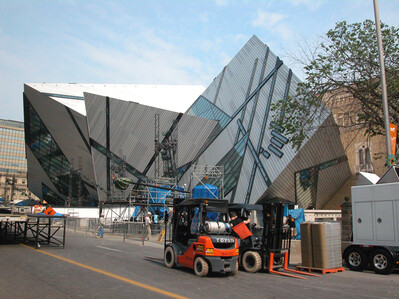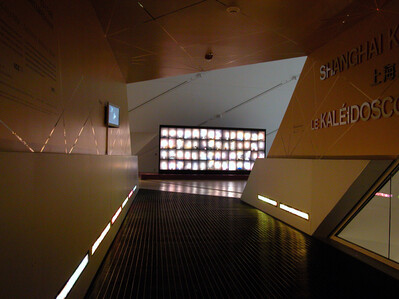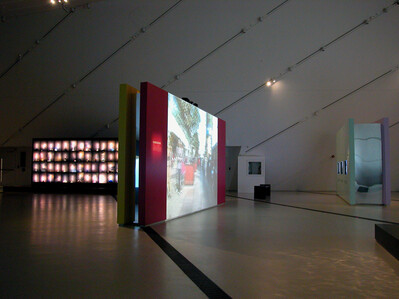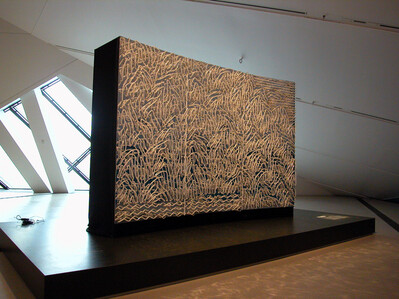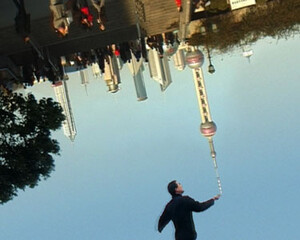Group Exhibition Royal Ontario Museum (ROM), Toronto, Canada
ICC at the ROM exhibition opens Sunday, May 4, 2008
The Institute for Contemporary Culture (ICC) at the Royal Ontario Museum (ROM) presents Shanghai Kaleidoscope from May 4, 2008 to November 2, 2008. Organized by the ICC at the ROM and guest-curated by Christopher Phillips of New York's International Center for Photography, the exhibition will offer an unprecedented view of one of the world's most dynamic cities, highlighting an emerging generation of Chinese artists, architects and fashion designers. The exhibition, presented by Manulife Financial, will be on display in the ICC's Roloff Beny Gallery on Level 4 of the Michael Lee-Chin Crystal.
Shanghai Kaleidoscope focuses on the key aspects of the city's vibrant culture: architecture, urban design, contemporary art, cinema and fashion. Working with the ICC, curatorial consultant Christopher Phillips has created the world's first exhibition that examines the city’s fascinating and quick reconfiguration as a 21st century city through an adventurous mix of video installations, photo-works, designer fashion apparel, runway videos and films by Shanghai's leading contemporary artists and designers. The exhibition provides an insider's view of the city's high-speed, high-density, high-rise culture, seen from the vantage point of those who are taking part in its astonishing transformation and growth.
"We're pleased to present these impressive works by some of China's most talented contemporary artists and designers," said William Thorsell, ROM Director and CEO. "The spacious, angular ICC gallery will provide a dramatic backdrop to evoke the energy and vitality of contemporary Shanghai for the ROM's visitors.
Since the early 1990s, Shanghai has been one of the world's fastest-changing cities. In the last ten years, approximately 60% of the old city has been razed and covered with new construction. Thousands of skyscrapers have been erected, a new subway system built, an ultramodern international airport and numerous new bridges and tunnels have been constructed. With 20 million inhabitants, it has become China's largest, most dynamic and globally connected city. This rush to economic power has encouraged the rise of a remarkable cultural life.
"Shanghai, a city with a legendary past, is fast becoming Asia's centre for imaginative art, architecture, and fashion," said Christopher Phillips, one of the world's leading experts on contemporary Chinese culture. "By exploring the latest directions taken by Shanghai's most creative young talents, the ICC exhibition will bring the extraordinary sights and sounds of contemporary Shanghai to Toronto."
"Manulife is proud to sponsor Shanghai Kaleidoscope. As a company with our Chinese headquarters in Shanghai, we are struck by the rapid transformation taking place," said Donald Guloien, Senior Executive Vice President and Chief Investment Officer, Manulife Financial. "We are delighted to help bring this important showcase of Shanghai's vibrant culture to the Royal Ontario Museum."
About the exhibition:
A vibrant contemporary art scene has arisen in Shanghai since the mid-1990s and numerous art galleries and centres are constantly being built or expanded to support the art boom. Many of the exhibition's works, ranging from realistic imagery to more experimental pieces, juxtapose historic Shanghai with the emergence of the modern city, illustrating the changes made to the urban fabric of Shanghai and commenting on the impact this new city has on its inhabitants.
Artist Shi Yong, a Shanghai native, has witnessed his city's transformation, now boasting more than 4,000 skyscrapers (twice as many as New York). For the artist, the city appears as a kind of virtual-reality, populated with "mirage-like" buildings. In Gravity: Shanghai Night Sky (2004), he responds to this phenomenon by creating a two-metre high by five-metre wide (7.8-ft by 18-ft) configuration of 56 lightbox-mounted photographic transparencies. A short video entitled Crumpling Shanghai (2000) by Song Dong captures the artist abruptly crumpling white sheets of paper that show contemporary Shanghai street scenes. This series of disappearing images suggest the fragility and transience of urban life.
Shen Fan, a Shanghai painter whose minimalist, monochromatic shapes often suggest natural forms, has created a smaller version of his monumental neon installation that was originally presented at the 2006 Shanghai Biennale. The piece, entitled Landscape: Commemorating Huang Binhong (small version, 2007), is a "painting" composed of 360 neon tubes designed to suggest both the short brushstrokes reminiscent of traditional Chinese ink painting as well as contemporary Shanghai's neon-illuminated nightscape. The work is dedicated to the celebrated artist Huang Binhong (1864-1955), one of the leading 20th-century innovators in traditional Chinese painting, who was famous for his freehand landscapes.
Yang Zhenzhong's short video loop Light and Easy 2 (2002) depicts the artist attempting to balance on his fingertip a skyscraper in Shanghai's Pudong area, the financial district located on the east side of the Huangpu River. His piece explores the idea of how "effortlessly" the city's residents have adapted to the rapid urban development, while also hinting at the topsy-turvy quality of the new landscape. Visitors can experience Yang Zhenzhong's Let's Puff (2002) by walking between two large video screens. This installation creates a visual metaphor for the winds of change that have swept through China's cities during the past decade. On one side a woman inhales and exhales with great force. At each exhalation, a central Shanghai street scene suddenly accelerates on the opposite screen.
A three-screen video installation entitled Flutter, Flutter, Jasmine, Jasmine (2002) by Yang Fudong tells a fictitious and fragmented story about a Chinese couple living in one of Shanghai's high rises. The characters speak frankly to the camera about their insecurities and at the end they pledge their love to one another from the building's rooftop. The video sequence contrasts their naive idealism with images of the city's harsh landscape. Visitors can also experience a short silent film entitled Site Specific_SHANGHAI 04 (2004) by Italian artist Olivo Barbieri. Shanghai's landscape has drastically changed since he first visited there almost 20 years ago. The artist films these dramatic changes to the city's landscape from a helicopter. He intentionally avoids the most famous sites and instead presents a sprawling city through anonymous 30- and 40-story buildings.
Another section features the work of three contemporary Chinese fashion designers, accompanied with runway videos. Wang Yiyang, one of China's most internationally acclaimed young fashion designers, employs a modern approach to traditional Chinese garments, such as his summer 2005 collection entitled Blue, made of the blue fabric favoured by Chinese living in rural areas. Here he presents his Spring 2008 fashion designs. Zhang Da's designs combine the traditional Chinese method of flat cutting with a style that employs minimal cuts and stitches without using darts. Gao Xin, one of Shanghai's emerging designers, has a reputation for edgy, urban fashion that appeals to a youthful clientele. His Even Penniless line is known for a deconstructed masculine silhouette in women's clothing with imaginative zippers, buttons and ribbon. On display here are his Winter 2008 designs.
The exhibition also offers a selection of photographic and film experiences. Beijing artist Shi Guorui uses the camera obscura technique to create large haunting silver gelatin prints of contemporary Shanghai entitled Shanghai, April 8-9, 2005 (2005) and Shanghai 1, August 18-19, 2004 (2004). These negative prints were created over an eight-hour exposure from a hotel window overlooking the banks of the Huangpu River. Crystal CG, one of China's most innovative digital multimedia companies, has created the computer animation Shanghai Panorama 2008 (2008), a fly-through tour of contemporary Shanghai that provides a soaring, futuristic vision of China's largest and most dynamic city. A digital display of 35 photographs by Canadian-born Shanghai resident Greg Girard presents the demolition of the old city and the construction of the new metropolis. Visitors can also view six video statements by Shanghai residents who are among the city's artists, fashion designers, filmmakers, and curators.
Other information:
From April 26, 2008 to October 26, 2008, coinciding with Shanghai Kaleidoscope, the ROM presents Shanghai 1860 -1940: Historical Photographs, a selection of 80 historical photographs of Shanghai in the Herman Herzog Levy Gallery on Level 1. Personal, powerful and poignant images document the development of Shanghai to China's foremost commercial and cultural centre in the early 20th century up to the radical changes of 1949, when the People's Republic of China was established.
These two exhibitions add an exciting contemporary dimension to the ROM's longstanding commitment to East Asian art and architecture. The Museum's outstanding Chinese collection, ranked among the finest outside China, is featured in four galleries located on the main floor of its historic buildings: the Joey and Toby Tanenbaum Gallery of China, the Bishop White Gallery of Chinese Temple Art, the Matthews Family Court of Chinese Sculpture, and the ROM Gallery of Chinese Architecture.
ROM Museum Guides will offer tours of these two exhibitions throughout the duration of Shanghai Kaleidoscope. For the month of May, tours of the East Asian galleries will be available in Cantonese and Mandarin, upon request. Please contact the Museum Sales Dept. at 416.586.5889 or groupsales@rom.on.ca to reserve a tour.
A colourful 144-page catalogue entitled Shanghai Kaleidoscope features general information and essays on Shanghai and interviews with the artists, designers and architects on their experiences in working in one of the world's fastest-changing cities. Exhibition curator and lead author Christopher Phillips has brought together numerous images and bold graphic design. The catalogue, designed by Interbrand Canada, will be available in the ROM Museum Store for $60 (hardcover) and $40 (softcover) plus applicable taxes. Visitors can also find a beautiful selection of Chinese-related merchandise and books at the ROM Museum Store.
On Saturday, May 3, 2008, the ROM celebrates the opening of Shanghai Kaleidoscope with the 2008 Imperial Ball, the Chinese Cultural Centre of Greater Toronto's annual fundraising gala. For this spectacular event, guests will enjoy an exclusive tour of the exhibition, gourmet dining prepared by ROM chefs, live performances, silent auction and dancing in the Michael Lee-Chin Crystal. For more information on this gala and the Chinese Cultural Centre, please visit www.cccgt.org.
As part of Asian Heritage Month, the ROM is pleased to present China Month, a series of Chinese-themed lectures, films and musical performances throughout the month of May. On May 4, 2007 at 3 pm, the ROM and WNED-PBS TV present a screening of the 1934 Chinese silent film classic The Goddess (Shen nü). Prior to the film, Dr. Richard Meyer, President Emeritus of the San Francisco Silent Film Festival, Seattle University film professor and Visiting Professor at the Center for Journalism and Media Studies at the University of Hong Kong will speak about the Shanghai film industry. This lecture and Sunday programming are free with general Museum admission. Some events are ticketed and registration is required. More programming will be added, including events produced by the ICC at the ROM during the engagement of Shanghai Kaleidoscope. Visitors can also enjoy special Chinese-inspired cuisine in Food Studio and c5 Restaurant Lounge. Visit www.rom.on.ca for more details.
Institute for Contemporary Culture:
The ICC at the ROM plays a vital role in a museum whose collections embrace many civilizations, as well as the record of nature through the ages. In the context of the ROM's lively documentation of history, the ICC explores current cultural issues through exhibitions of art and architecture, lectures, film series, and informal gatherings. For more information on the ICC, visit www.rom.on.ca/about/icc.
More Pictures:

